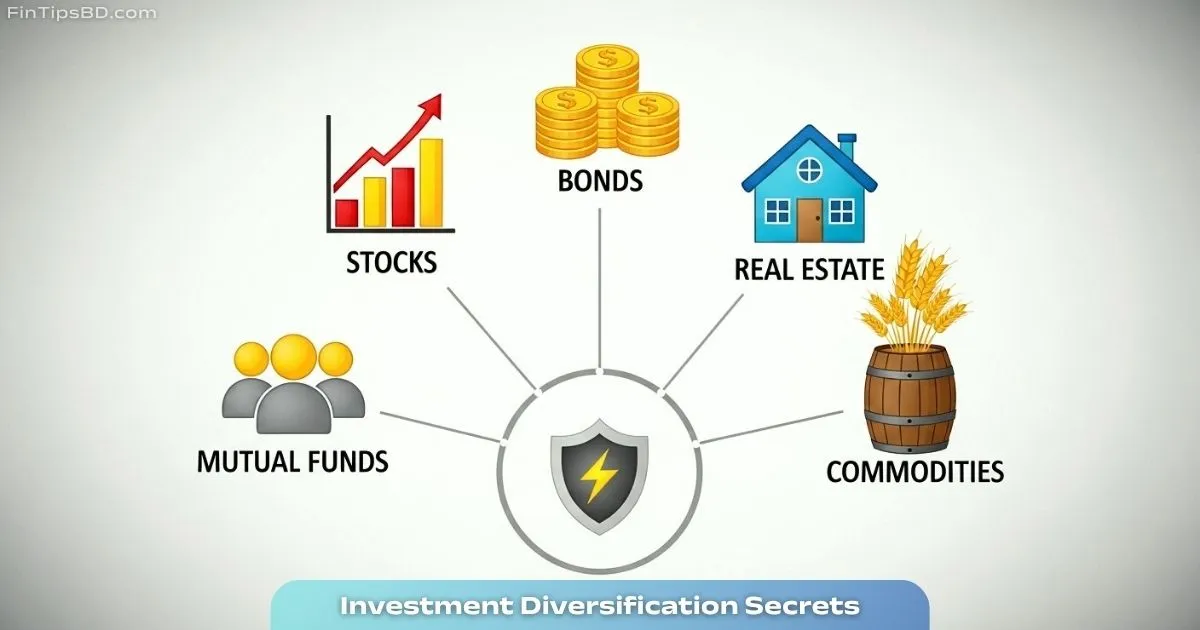Investment Diversification Secrets – The One Mistake That Could Ruin Your Portfolio

Investment diversification is a phrase tossed around so often in financial conversations that it risks fading into background noise. Many people agree with it in theory, often referencing the old saying, “don’t put all your eggs in one basket.” While that idea captures the essence, it barely touches the depth of what real diversification actually means. In today’s complex financial landscape, neglecting to diversify properly doesn’t just mean taking on more risk—it can be the very misstep that ruins your entire portfolio, wiping out years of disciplined financial growth.
This guide digs deeper, showing you what authentic investment diversification involves, how it forms the backbone of protecting your long-term financial health, and the critical error even experienced investors often make—thinking they’re diversified when they’re not.
Table Of Contents
What Does Investment Diversification Really Mean?
At its foundation, investment diversification is the intentional method of distributing your money across multiple asset categories, industries, and even global markets. The main objective is simple: to lower the chances of significant losses by not relying too heavily on any single investment, economic condition, or market swing. It’s a vital element of wise financial planning.
Instead of betting heavily on just a few stocks or placing all your funds in one industry, a well-diversified investor spreads their money across a broad range of investment tools. These can include:
- Stocks: Across a mix of industries such as healthcare, tech, consumer goods, and energy, plus different company sizes and geographic regions.
- Bonds: Including government, corporate, and municipal bonds, with different durations and risk levels.
- Real Estate: Either through REITs or owning property directly.
- Commodities: Assets like gold or oil that can protect against inflation.
- Global Markets: Allowing access to international economies outside your home base.
- Cash and Short-Term Holdings: Useful for quick access and managing day-to-day financial needs, crucial for budgeting and short-term planning.
Think of a solidly diversified portfolio like a full orchestra rather than a solo act. Each asset class plays its own part. If one instrument section goes quiet or misses a note, others can pick up the rhythm, preserving the overall performance. This kind of balance not only protects your returns—it minimizes the impact of any one investment falling flat.
The Dangerous Illusion: The One Mistake That Could Decimate Your Portfolio
One of the most harmful mistakes in investing isn’t choosing a bad stock or missing market timing. It’s far sneakier: believing you’re diversified when, in reality, you’re not. This false sense of security is one of the biggest blind spots in personal finance protection.
Plenty of investors wrongly assume that owning shares in several companies equals portfolio diversification. But if those businesses all fall within the same industry, have similar market sizes, or are based in one country, your exposure to risk remains high—even if it doesn’t seem that way at first glance. This narrow investment approach can derail your financial progress and sabotage your wealth goals.
A Common Trap: The Technology Overload
Take a typical case: someone holds stocks in top tech firms like Amazon, Apple, Microsoft, and Alphabet. On paper, that might look like variety, but in practice, it’s far from genuine diversification. These companies often move in the same direction during market turbulence, meaning a tech sector downturn could lead to major losses across all holdings.
This is not true investment diversification—it’s a mirage. It underlines why understanding how different investments move in relation to one another (correlation) is just as crucial as the number of holdings in your portfolio.
Why True Investment Diversification Is Absolutely Essential

Authentic investment diversification acts like a protective barrier, aimed at lowering your overall portfolio risk without necessarily giving up the chance for strong long-term returns. It works behind the scenes to ease the sharp ups and downs of the market, helping investors stay calm and committed even during shaky times. It’s a key part of sticking to your financial planning goals.
Real Advantages of Proper Diversification:
- Stronger Risk Management: Diversifying significantly lowers the impact a single poorly performing investment or sector can have on your total portfolio.
- Smoother Returns Over Time: Gains in one part of your portfolio can help balance out setbacks in another, leading to more stable and steady progress.
- Built-in Flexibility: A well-spread portfolio is better equipped to adapt and stay strong through all sorts of economic situations—from booms to recessions.
- Peace of Mind: Knowing that your investments are well-diversified can help you stay cool when markets swing wildly, keeping you from making emotional, costly decisions.
Ultimately, investment diversification serves as your personal safety net. It shields your savings from relying too much on any one outcome—be it a specific investment type or a temporary market trend. Think of it as being just as important as negotiating a raise—it’s a smart move that strengthens your overall financial picture.
Simple Tactics to Build Genuine Investment Diversification

If you want to avoid falling into the trap of fake diversification, you need to follow a well-planned and thoughtful approach. Here’s how to create a properly balanced and risk-aware portfolio that supports both long-term investing and your personal finance protection goals.
1. Spread Investments Across Multiple Asset Types
Your first step is to divide your investments among a variety of asset groups. Each asset type reacts differently to market and economic conditions.
- Stocks (Equities): These can grow significantly over time, but they also tend to be more unpredictable.
- Bonds (Fixed Income): These are typically steadier and provide regular income, making them a useful balance when stocks are volatile.
- Real Estate: Offers long-term value, potential income through rent, and can help guard against inflation.
- Cash or Short-Term Funds: Keeps your finances flexible, acts as an emergency buffer, and helps with short-term planning.
- Commodities: Assets like gold or oil can act as inflation hedges and respond to changes in supply and demand globally.
Blending these categories helps create a solid, well-rounded financial base—key to steady wealth building.
2. Diversify Within Each Investment Group
True investment diversification doesn’t stop at simply choosing different asset types. You also need to branch out within each category.
- Within Stocks: Don’t limit yourself to a few big-name tech companies. Include firms from sectors like healthcare, consumer goods, finance, and energy. Mix in companies of different sizes—from small startups to large corporations—and consider both growth and value investing styles.
- Within Bonds: Include a mix of short-term, mid-term, and long-term options. Use both government and corporate bonds, and consider municipal bonds for their tax advantages.
- Across Countries: Relying solely on your home country’s economy can expose you to unnecessary risk. Adding international investments—both in established markets and emerging ones—brings balance and opens up more growth opportunities. This is one of the smartest ways to diversify your investments.
By spreading out your investments in these ways, you reduce the chance that a downturn in one sector or region will hit your entire portfolio hard—a key element of risk management and portfolio diversification.
3. Use Mutual Funds and ETFs Carefully
A lot of investors use mutual funds or ETFs as an easy way to diversify. While these can be helpful, they’re not always as broad as they seem. Some funds hold many of the same stocks or focus too heavily on one area.
Before putting your money into any fund, look closely at what it holds. Check its exposure to various regions and sectors. Make sure it truly fits your overall investment diversification strategy and supports your long-term goals. Don’t just trust the label—dig into the details.
4. Personalizing Your Investment Diversification Strategy
Investment diversification isn’t a universal formula. The ideal mix of assets for your portfolio depends entirely on your personal situation and financial goals. Customizing your asset allocation ensures that your strategy works for you—not someone else.
- Age: Younger investors often have the benefit of time. With a longer investment window, they can generally take on more stock market exposure since they have more time to recover from potential downturns. In contrast, those approaching retirement may lean toward safer investments like bonds and income-generating assets to reduce risk and secure stable returns.
- Risk Tolerance: How much volatility can you handle without panicking? Your comfort with risk should directly influence how you diversify your investments. If big market swings keep you up at night, a more conservative, balanced approach might suit you better.
- Financial Objectives: What are you investing for? Saving for a home in the next few years calls for a lower-risk portfolio with more liquidity. On the other hand, preparing for retirement over several decades gives you room to take on more risk and aim for growth. Each goal demands a different balance between risk and return.
- Investment Time Frame: The more time you have, the more flexibility you gain. A longer timeline allows for more growth-focused assets, like stocks, since short-term drops have time to recover. Shorter time frames call for greater stability to preserve your capital.
Take this example: A 30-year-old focused on retirement savings might hold a larger share of equities, aiming for long-term appreciation. Meanwhile, a person in their 60s may wisely favor more bonds and dividend-paying investments, aiming to protect their capital while generating steady income. This tailored approach is a key principle in smart money management and effective financial planning.
Mastering the Art of Rebalancing: Keep Your Diversification on Track
Even the most carefully planned, well-balanced portfolio doesn’t stay that way forever. Over time, certain investments will grow faster than others, throwing off your original strategy. This shift changes your portfolio’s risk level, possibly exposing you to more risk—or less return—than you intended. That’s why rebalancing is a crucial part of smart, long-term investing.
Signs It’s Time to Rebalance:
- Outperformance of a Specific Asset Type: If your stock investments have grown well beyond your intended limit after a market upswing, your portfolio may be too heavily tilted toward riskier assets.
- Change in Risk Tolerance: If you’re feeling more (or less) nervous about market swings, it might be time to reassess how your money is allocated.
- Major Life Events: Big life changes—like switching careers, getting married, having kids, or nearing retirement—are all reasons to recheck your strategy and rebalance accordingly.
Most financial professionals recommend reviewing your portfolio at least once per year—or after big market movements—to make sure your asset allocation still matches your goals. Staying proactive here keeps your financial planning efforts focused and your wealth building strategy strong.
Breaking Down Harmful Diversification Myths

Even with the best intentions, investors can fall for misleading beliefs that seem like diversification but actually leave portfolios vulnerable. Let’s clear up some common myths that can harm your personal finance protection.
Myth #1: “Owning Many Stocks = Real Diversification”
Quantity doesn’t always mean safety. For example, if you own 25 different tech stocks, you’re still heavily exposed to a single industry. When that sector crashes, all your investments could drop at once. True portfolio diversification means owning different types of assets, not just more of the same kind.
Myth #2: “Investing Globally Is Too Dangerous”
This is one of the most harmful misunderstandings. In reality, global diversification can actually reduce risk by spreading exposure across countries with different economic cycles. If you only invest domestically, you’re placing all your bets on one economy. Adding international holdings is a smart way to diversify your investments and improve long-term resilience.
Myth #3: “Bonds Are Only for Older Investors”
Bonds play a key role in nearly every portfolio. They help soften the blow when stocks take a hit and offer more consistent returns. Whether you’re 25 or 65, having bonds as part of your asset allocation can balance risk and smooth out market ups and downs. They’re a smart choice in any financial planning strategy.
Final Thoughts: Don’t Let False Confidence Sabotage Your Future
Investment diversification isn’t about randomly picking assets and hoping for the best. It’s a thoughtful process that involves building a portfolio with clear purpose, solid research, and good risk control. The biggest mistake investors make is assuming they’re protected when their portfolios are actually unbalanced and overexposed.
Take time today to review your investments. Are they spread out across different industries, asset classes, and regions? Are you avoiding heavy concentration in one sector or type of stock? If not, now’s the perfect time to fix it. Making even small adjustments today could save you from major losses in the future.
Stay consistent. Review your strategy regularly. Avoid unnecessary complexity. The real key to smart, long-term investing isn’t gambling for quick wins—it’s avoiding common investment mistakes, managing risk well, and building a balanced portfolio that can grow steadily over time.
By sticking to these principles, you’ll strengthen your financial foundation, support your debt management goals, and lay the groundwork for lasting success in your wealth building journey.
Keywords: portfolio diversification, asset allocation, diversify your investments, financial planning, long-term investing, balanced portfolio, investment mistakes, risk management, personal finance protection, how to diversify investments, ignoring investment diversification, investment diversification secrets
